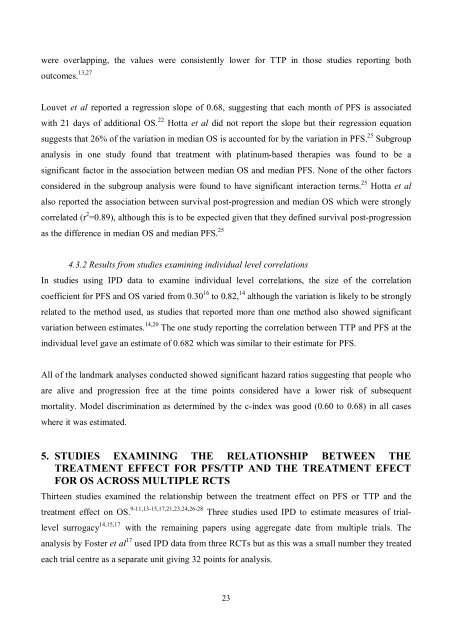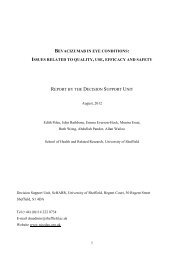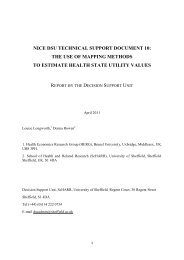A review of studies examining the relationship between progression ...
A review of studies examining the relationship between progression ...
A review of studies examining the relationship between progression ...
Create successful ePaper yourself
Turn your PDF publications into a flip-book with our unique Google optimized e-Paper software.
were overlapping, <strong>the</strong> values were consistently lower for TTP in those <strong>studies</strong> reporting bothoutcomes. 13,27Louvet et al reported a regression slope <strong>of</strong> 0.68, suggesting that each month <strong>of</strong> PFS is associatedwith 21 days <strong>of</strong> additional OS. 22 Hotta et al did not report <strong>the</strong> slope but <strong>the</strong>ir regression equationsuggests that 26% <strong>of</strong> <strong>the</strong> variation in median OS is accounted for by <strong>the</strong> variation in PFS. 25 Subgroupanalysis in one study found that treatment with platinum-based <strong>the</strong>rapies was found to be asignificant factor in <strong>the</strong> association <strong>between</strong> median OS and median PFS. None <strong>of</strong> <strong>the</strong> o<strong>the</strong>r factorsconsidered in <strong>the</strong> subgroup analysis were found to have significant interaction terms. 25 Hotta et alalso reported <strong>the</strong> association <strong>between</strong> survival post-<strong>progression</strong> and median OS which were stronglycorrelated (r 2 =0.89), although this is to be expected given that <strong>the</strong>y defined survival post-<strong>progression</strong>as <strong>the</strong> difference in median OS and median PFS. 254.3.2 Results from <strong>studies</strong> <strong>examining</strong> individual level correlationsIn <strong>studies</strong> using IPD data to examine individual level correlations, <strong>the</strong> size <strong>of</strong> <strong>the</strong> correlationcoefficient for PFS and OS varied from 0.30 16 to 0.82, 14 although <strong>the</strong> variation is likely to be stronglyrelated to <strong>the</strong> method used, as <strong>studies</strong> that reported more than one method also showed significantvariation <strong>between</strong> estimates. 14,20 The one study reporting <strong>the</strong> correlation <strong>between</strong> TTP and PFS at <strong>the</strong>individual level gave an estimate <strong>of</strong> 0.682 which was similar to <strong>the</strong>ir estimate for PFS.All <strong>of</strong> <strong>the</strong> landmark analyses conducted showed significant hazard ratios suggesting that people whoare alive and <strong>progression</strong> free at <strong>the</strong> time points considered have a lower risk <strong>of</strong> subsequentmortality. Model discrimination as determined by <strong>the</strong> c-index was good (0.60 to 0.68) in all caseswhere it was estimated.5. STUDIES EXAMINING THE RELATIONSHIP BETWEEN THETREATMENT EFFECT FOR PFS/TTP AND THE TREATMENT EFECTFOR OS ACROSS MULTIPLE RCTSThirteen <strong>studies</strong> examined <strong>the</strong> <strong>relationship</strong> <strong>between</strong> <strong>the</strong> treatment effect on PFS or TTP and <strong>the</strong>treatment effect on OS. 9-11,13-15,17,21,23,24,26-28 Three <strong>studies</strong> used IPD to estimate measures <strong>of</strong> triallevelsurrogacy 14,15,17with <strong>the</strong> remaining papers using aggregate date from multiple trials. Theanalysis by Foster et al 17 used IPD data from three RCTs but as this was a small number <strong>the</strong>y treatedeach trial centre as a separate unit giving 32 points for analysis.23





